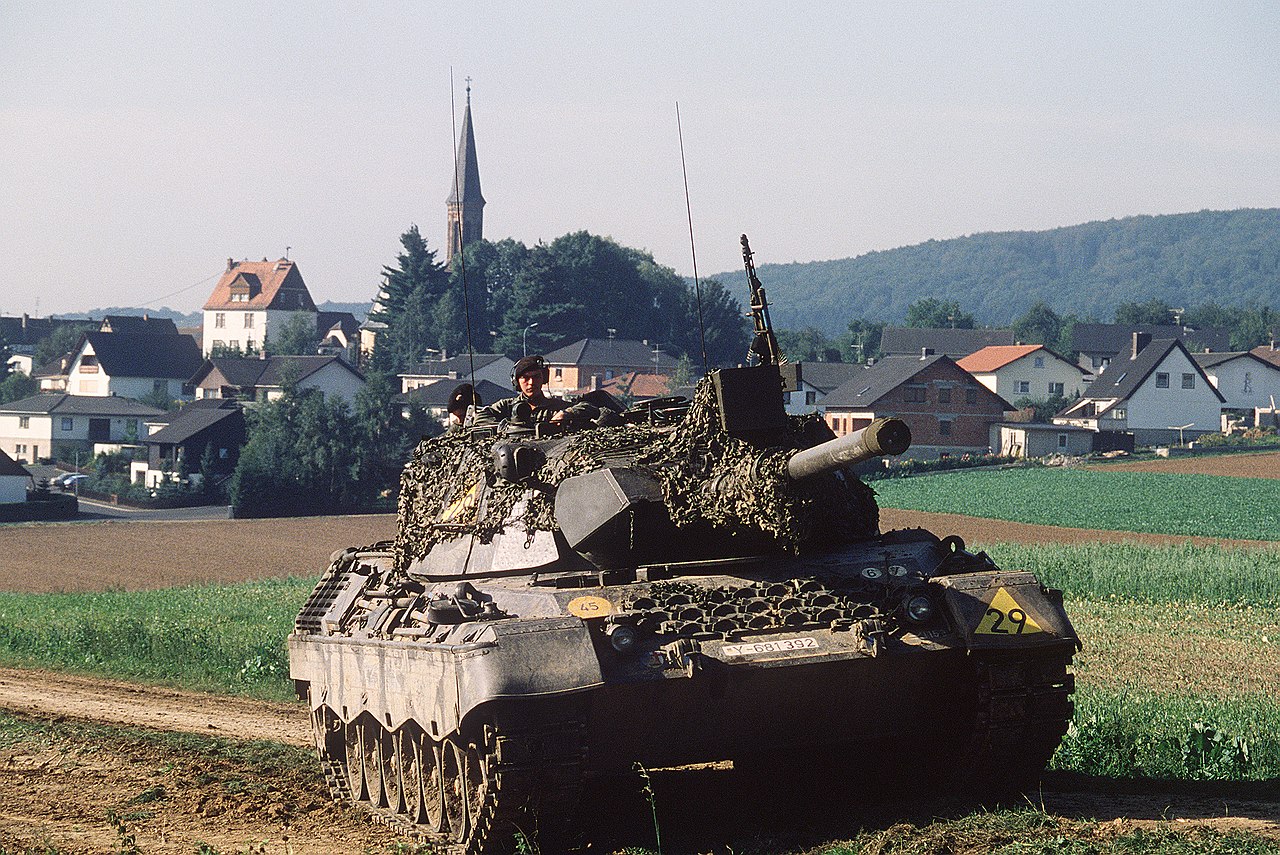Designed 1956–1966
No. built 4,744 main battle tanks
1,741 utility and anti-aircraft vehicles
80 prototypes and pre-series vehicles
Specifications
Weight 42.2 tonnes (increased on later models from original 40.0 tonnes)
Length 9.54/8.29 m (gun forward/rearward)
Width 3.37 m
Height 2.39/2.70 m (turret roof/absolute
Crew 4 (commander, driver, gunner, radio operator/loader)
Armor steel 19–21.7mm and 10–70 mm RHA
Main armament
1 × 105 mm Royal Ordnance L7A3 L/52 rifled gun
(13 rounds in turret 42 rounds in hull)
Secondary armament
2 × 7.62 mm MG 3 or FN MAG (co-axial and commander's hatch) (5500 rounds)
EngineMTU MB 838 CaM 500, 10-cylinder, 37.4 litres, multi-fuel engine
830 PS (819 hp, 610 kW) at 2,200 RPM
Power/weight 19.6 PS (14.5 kW) /tonne
Suspension Torsion-bar
Operational range 600 km (on road), 450 km (cross-country)
Speed 65 km/h
Design
Hull & turret
The Leopard had well-sloped, electrically welded, rolled homogeneous armor (RHA), not especially thick. It was only 19 to 21.7 mm (0.75-0.85 in) thick and up to 70 mm (2.76 in) on the turret front and mantlet. Since new hollow-charge projectiles could pierce through a theoretical 250 mm (9.84 in) of armor, this was useless. This RHA enabled characteristics like a uniform, tougher and elongated grain structure, which diminished or spread the stress of an impact. However, with the improved ammunition, it was envisioned an evolution towards add-on composite armor, achieved on following versions.
The turret was cast at first, with a distinctive rear overhang, and built around the British L7 Royal Ordinance 105 mm (4.13 in) gun, then a standard inside NATO, also adopted by the new generation of US tanks, like the M60. On the definitive version, the turret was welded, with extra external and internal equipment. This turret was mounted on a large ring, whose diameter was superior to the lower hull width. In fact it reached the half-width of the tracks, thanks to extended sloped sides, which replaced the catwalks. Mudguards were short and limited to the frontal sloped section. All external equipment, like the towing cable, bars, schnorkel tube and others, were carried much like on the wartime Panther and Tiger II.
The turret top was dotted with two cupolas, one for the commander and one for the gunner, rotatable, and fitted with prismatic vision blocks. Both had night vision/magnification periscopes installed in front of them. A characteristic of the turret were the two frontal telemetric “bumps” on each side, for long-range gunnery. The turret housed the radio, 13 ready-made rounds of various types, and there was a small basket at the rear surrounded by a storage cage. The hull and turret were sealed and tested to be water-proof in case of submerged crossing and treated NBC (nuclear, bacteriologic, chemical) from the start. This turret was completely modified in later versions.
Armament
From the start, the “Leo” adopted the British-built Royal Ordinance L7A3 105 mm (4.13 in) gun, largely used inside NATO, including by US models like the M60. It featured a 52-caliber, rifled, 5.89 m long (19ft 4in) barrel and weighed 1282 kg (2826 lbs). It had a rate of fire of 10 rounds per minute (tested, with good training), and fired standard 610 or 617 long ammunition of every type available in the NATO, namely HEAT, HE rounds (1700 m/s or 1860 yd/s), HESH rounds, APERS-T (antipersonnel), dummy, canister, training rounds and, for antitank purpose, APDS and APFSDS (“sabot”), reaching 1475 m/s (1613 yd/s) muzzle velocity with these.
The L7A3 was purpose-built in Germany, with the particular of having the corner of the breech block reduced in size so the gun could be depressed more without obstruction from the roof. 13 rounds were stored inside the turret and 42 into the hull. The L7 was well-known and well-proven as very accurate even at very long range (up to 3000 m/3300 yd).
In addition, there was a coaxial MG 3 or FN MAG for the gunner and a secondary one for the commander, mounted on a circular ring around his cupola. 5500 rounds were in store for these. There were not many modifications to the gun apart adding thermal sleeves and upgrading the laser rangefinder and fire control system (FCS).
Engine & transmission
The heart of the Leopard was a MTU (Motoren- und Turbinenunion) MB 838 CaM 500, ten-cylinder, 37.4 liters, multi-fuel engine. It could take either diesel or gasoline, even aviation gasoline if needed. It gave 830 PS (819 hp, 610 kW) at 2200 RPM, and 19.6 PS per tonne. This gave the relatively lightweight hull excellent performances. The transmission was a ZF 4HP250 (Zahnradfabrik Friedrichshafen) model with 4 forward and 2 reverse gears. Engine and transmission were designed to be lifted and replaced in less than 20 minutes in the field by well-trained crews.
Drivetrain
The torsion bar suspension consisted of seven roadwheels, drive sprocket at the rear and idler at the front. In addition to the torsion bars, there were shock absorbers on the three front and two rear roadwheels on each side. This combination gave them a very smooth ride and was highly tested and refined for optimal cross-country performances. It stands for one of the most efficient combination ever created and influenced many foreign designs. The Leopard, when fitted with a deep wading kit, could ford rivers up to 4 m (13 ft) deep. Field test performances showed it could reach 65 km/h (40.39 mph) on road, climb a 60% gradient, 40% side slope, 1.15 m (3.77 m) vertical step, cross a 3 meter (9.84 ft) trench and ford (without preparation)

Last edited:
